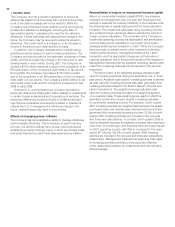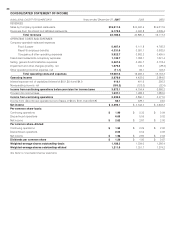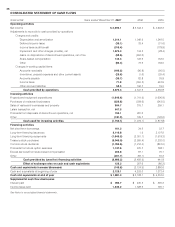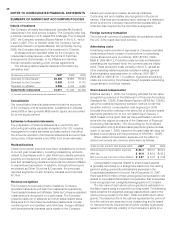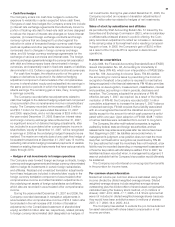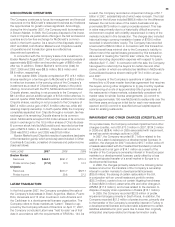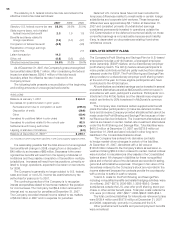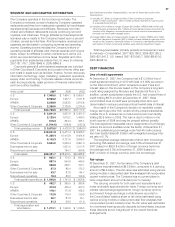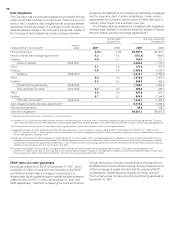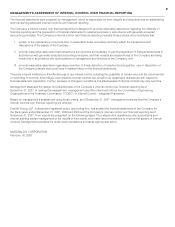McDonalds 2007 Annual Report Download - page 53
Download and view the complete annual report
Please find page 53 of the 2007 McDonalds annual report below. You can navigate through the pages in the report by either clicking on the pages listed below, or by using the keyword search tool below to find specific information within the annual report.• Cash fl ow hedges
The Company enters into cash fl ow hedges to reduce the
exposure to variability in certain expected future cash fl ows.
The types of cash fl ow hedges the Company enters into include
(i) interest rate exchange agreements that effectively convert a
portion of fl oating-rate debt to fi xed-rate debt and are designed
to reduce the impact of interest rate changes on future interest
expense; (ii) forward foreign exchange contracts and foreign
currency options that are designed to protect against the
reduction in value of forecasted foreign currency cash fl ows
(such as royalties and other payments denominated in foreign
currencies) due to changes in foreign currency exchange
rates; and (iii) foreign currency exchange agreements for the
exchange of various currencies and interest rates. The foreign
currency exchange agreements hedge the currency risk associated
with debt and intercompany loans denominated in foreign
currencies, and essentially result in fi xed-rate assets or liabilities
denominated in U.S. Dollars or appropriate functional currencies.
For cash fl ow hedges, the effective portion of the gains or
losses on derivatives is reported in the deferred hedging
adjustment component of accumulated other comprehensive
income in shareholders’ equity and reclassifi ed into earnings in
the same period or periods in which the hedged transaction
affects earnings. The remaining gain or loss, if any, is recognized
in earnings currently.
The Company recorded after-tax adjustments related to
cash fl ow hedges to the deferred hedging adjustment component
of accumulated other comprehensive income in shareholders’
equity. The Company recorded net increases of $8.5 million
and $10.7 million for the years ended December 31, 2007
and 2006, respectively, and a net decrease of $2.8 million for
the year ended December 31, 2005. Based on interest rates
and foreign currency exchange rates at December 31, 2007,
no signifi cant amount of deferred hedging adjustments, after
tax, included in accumulated other comprehensive income in
shareholders’ equity at December 31, 2007, will be recognized
in earnings in 2008 as the underlying hedged transactions are
realized. The maximum maturity date of any cash fl ow hedge of
forecasted transactions at December 31, 2007 was 15 months,
excluding instruments hedging forecasted payments of variable
interest on existing fi nancial instruments that have various maturity
dates through 2013.
• Hedges of net investments in foreign operations
The Company uses forward foreign exchange contracts, foreign
currency exchange agreements and foreign currency denominated
debt to hedge its investments in certain foreign subsidiaries
and affi liates. Realized and unrealized translation adjustments
from these hedges are included in shareholders’ equity in the
foreign currency translation component of accumulated other
comprehensive income and offset translation adjustments on
the underlying net assets of foreign subsidiaries and affi liates,
which also are recorded in accumulated other comprehensive
income.
During the years ended December 31, 2007 and 2006, the
Company recorded decreases in translation adjustments in
accumulated other comprehensive income of $76.5 million after
tax (included in the net increase of $1.6 billion of translation
adjustments in the Consolidated statement of shareholders’
equity) and $23.2 million after tax, respectively, related primarily
to foreign currency denominated debt designated as hedges of
net investments. During the year ended December 31, 2005, the
Company recorded an increase in translation adjustments of
$356.8 million after tax related to hedges of net investments.
Sales of stock by subsidiaries and affi liates
As permitted by Staff Accounting Bulletin No. 51 issued by the
Securities and Exchange Commission (SEC), when a subsidiary
or affi liate sells unissued shares in a public offering, the Com-
pany records an adjustment to refl ect an increase or decrease
in the carrying value of its investment and a resulting nonoperat-
ing gain or loss. In 2006, the Company’s gain of $32.0 million
as a result of the Chipotle IPO is reported in discontinued
operations.
Income tax uncertainties
In July 2006, the Financial Accounting Standards Board (FASB)
issued Interpretation No. 48, Accounting for Uncertainty in
Income Taxes (FIN 48), which is an interpretation of FASB State-
ment No. 109, Accounting for Income Taxes. FIN 48 clarifi es
the accounting for income taxes by prescribing the minimum
recognition threshold a tax position is required to meet before
being recognized in the fi nancial statements. FIN 48 also provides
guidance on derecognition, measurement, classifi cation, interest
and penalties, accounting in interim periods, disclosure and
transition. The Company adopted the provisions of FIN 48
effective January 1, 2007, as required. As a result of the imple-
mentation of FIN 48, the Company recorded a $20.1 million
cumulative adjustment to increase the January 1, 2007 balance
of retained earnings. FIN 48 requires that a liability associated
with an unrecognized tax benefi t be classifi ed as a long-term
liability except for the amount for which cash payment is antici-
pated within one year. Upon adoption of FIN 48, $338.7 million
of net tax liabilities were reclassifi ed from current to long-term.
The Company, like other multi-national companies, is regularly
audited by federal, state and foreign tax authorities, and tax
assessments may arise several years after tax returns have been
fi led. Beginning in 2007, tax liabilities are recorded when, in
management’s judgment, a tax position does not meet the more
likely than not threshold for recognition as prescribed by FIN 48.
For tax positions that meet the more likely than not threshold, a tax
liability may be recorded depending on managment’s assessment
of how the tax position will ultimately be settled. Prior to 2007, tax
liabilities had been recorded when, in management’s judgment, it
was not probable that the Company’s tax position would ultimately
be sustained.
The Company records interest on unrecognized tax benefi ts
in the provision for income taxes.
Per common share information
Diluted net income per common share is calculated using net
income divided by diluted weighted-average shares. Diluted
weighted-average shares include weighted-average shares
outstanding plus the dilutive effect of share-based compensation
calculated using the treasury stock method, of (in millions of
shares): 2007–23.5; 2006–17.7; 2005 –13.8. Stock options that
were not included in diluted weighted-average shares because
they would have been antidilutive were (in millions of shares):
2007–0.7; 2006 –16.4; 2005 – 44.4.
The Company has elected to exclude the pro forma deferred
tax asset associated with share-based compensation in net
income per share.
51



